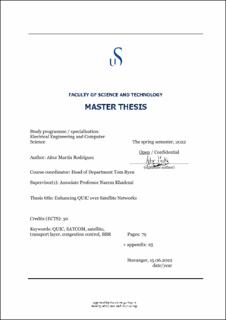| dc.description.abstract | The use of Satellite Communication (SATCOM) networks for broadband connectivity has recently seen an increase in popularity due to, among other factors, the rise of the latest generations of cellular networks (5G/6G) and the deployment of high-throughput satellites. In parallel, major advances have been witnessed in the context of the transport layer: first, the standardization and early deployment of QUIC, a new-generation and general-purpose transport protocol; and second, modern congestion control proposals such as the Bottleneck Bandwidth and Round-trip propagation time (BBR) algorithm. Even though satellite links introduce several challenges for transport layer mechanisms, mainly due to their long propagation delay, satellite Internet providers have relied on TCP connection-splitting solutions implemented by Performance-Enhancing Proxies (PEPs) to greatly overcome many of these challenges. However, due to QUIC's fully encrypted nature, these performance-boosting solutions become nearly impossible for QUIC traffic, leaving it in great disadvantage when competing against TCP-PEP. In this context, IETF QUIC WG contributors are currently investigating this matter and suggesting new solutions that can help improve QUIC's performance over SATCOM. This thesis aims to study some of these proposals and evaluate them through experimentation using a real network testbed and an emulated satellite link. | |
